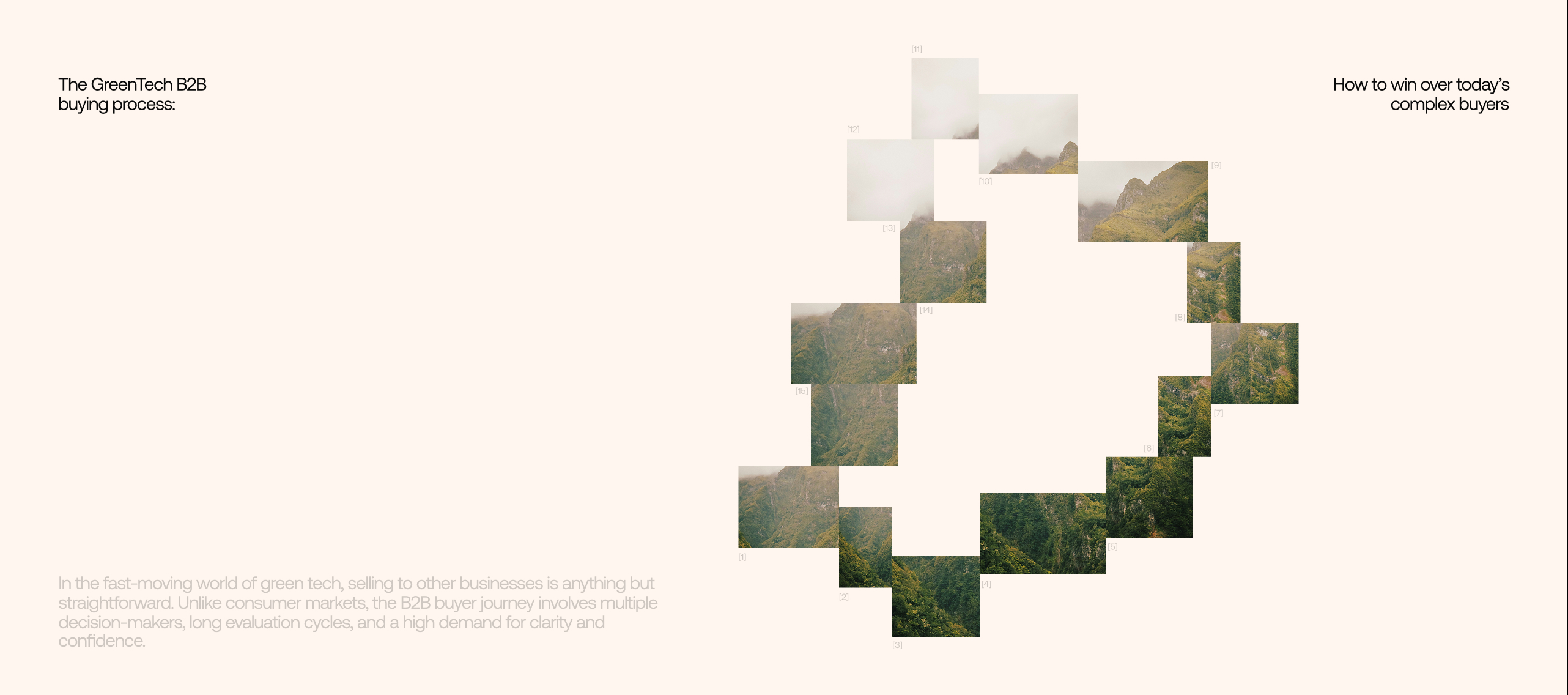

The GreenTech B2B buying process: How to win over today’s complex buyers
Marketing
29/7/2025
In the fast-moving world of green tech, selling to other businesses is anything but straightforward. Unlike consumer markets, the B2B buyer journey involves multiple decision-makers, long evaluation cycles, and a high demand for clarity and confidence.
Buyers aren’t just looking for innovative solutions but assessing how well a product fits into their operations, budgets, and long-term sustainability goals.
For green tech marketers and sales teams, understanding this complex decision-making process is essential. This article examines the logic behind green tech B2B purchases, revealing key patterns, bottlenecks, and strategies for winning over today’s informed buyers.
Understanding the complexity of the B2B buyer journey
The multi-stage nature of the B2B buying cycle
The B2B buyer journey in green tech is a multi-touch, often nonlinear process involving multiple stages and many decision-makers. Prospective clients don’t just compare product specifications but also evaluate the long-term business impact, regulatory compliance, and strategic alignment with sustainability goals.
• It includes problem identification, solution exploration, supplier selection, purchase decision, and post-purchase evaluation.
• Buyers often revisit earlier stages due to organisational shifts or new data.
Longer sales cycles and more complex purchases
Green tech solutions, whether energy storage, decarbonisation platforms, or circular economy software, are complex, expensive, and long-term. That leads to longer sales cycles, often stretching over 6 to 18 months.
Factors contributing to long timelines:
• Enterprise buyers require approval from senior management.
• Projects must align with broader sustainability and business goals.
• Legal, financial, and technical assessments often run in parallel.
The rise of informed buyers in digital channels
Today’s business buyers are more independent. According to Gartner, buyers prefer to self-educate before ever speaking with a sales rep. That means:
• Engaging with digital channels like blogs, whitepapers, and webinars.
• Researching vendors through user feedback, reviews, and competitor benchmarks.
• Expecting access to relevant and valuable information on demand.
Key traits of B2B buyers in GreenTech
Mission-driven but metrics-focused
While climate-consciousness matters, B2B decision makers still prioritise ROI, scalability, and operational impact. They care about:
• Emissions reductions plus business performance improvements.
• Supplier capabilities to deliver at scale.
• The monetary value of solutions, backed by case studies and data.
Senior management involvement in purchase decisions
Green tech purchase decisions often involve:
• CTOs, COOs, CFOs evaluating feasibility.
• CSOs ensuring sustainability targets are met.
• Procurement and legal departments reviewing compliance.
It’s a buying process that involves multiple decision makers, each with different priorities.
Preference for digital interactions and self-service options
Today’s B2B buyers expect:
• Self-service tools like ROI calculators
• Downloadable spec sheets and whitepapers
• Virtual demos before booking meetings
This mirrors business-to-client behaviour but with more rigour and expectations.
Demand for relevant and valuable information
From product specifications to implementation roadmaps, buyers want content tailored to:
• Their pain points
• Their role in the organisation
• Their stage in the purchasing journey
They are potential clients, not just leads, and need to be treated as such.
Common bottlenecks in the B2B buying process
Problem identification vs Solution exploration
Buyers may know they have a problem (e.g., high carbon footprint), but not the solution (e.g., carbon capture vs electrification). This leads to delays in the buying decisions stage.
Too many decision makers involved
The more stakeholders involved, the more difficult it is to reach a consensus. Each one brings its own concerns, such as financial risk, operational disruption, or a lack of technical clarity.
Unclear supplier capabilities
If your messaging doesn’t communicate:
• What your solution does
• How it integrates with existing systems
• The measurable business benefits
You are likely to be dropped from the shortlist. This is where buyer enablement content becomes essential.
Indecision and risk aversion
According to Ironpaper, decoding buyer indecision is key. Buyers fear making the wrong call, especially with complex purchases. Help them by:
• Sharing client references
• Providing free trials
• Addressing objections proactively
Mapping the GreenTech B2B purchase process
Initial pain point discovery
Starts with a trigger, regulatory changes, rising costs, or internal sustainability mandates. The buyer seeks to define the problem and begin researching.
Research and shortlisting of potential solutions
Buyers explore:
• Potential vendors
• Product benefits vs competitors
• Alignment with business needs
This often happens on digital platforms long before a phone call is made.
Supplier selection and trials
Prospective clients narrow down their options:
• Request demos
• Compare product specifications
• Review pricing, flexibility, and integrations
Purchase decision and contract finalisation
At this stage, the final pitch matters. Support your sales team with branded content and clear ROI evidence to convert the deal.
Post-purchase evaluation and repeat business
Delivering a great user experience post-sale increases chances of:
• Repeat purchases
• Referrals
• Repeat business from other departments or business units
Key insights to win over B2B buyers in sustainability tech
Provide free trials and client references
In more complex purchases, trust is essential. Buyers want to reduce risk, and offering the following can help:
• Free trials or pilot programmes to demonstrate effectiveness.
• Client references and success stories from similar industries.
• Post-trial data showing improvements in efficiency or sustainability metrics.
This reassures potential clients that your solution delivers on its promises.
Demonstrate ROI and business impact
Green tech buyers are tasked with meeting environmental goals while justifying spend to senior leaders. Help them build a business case by offering:
• ROI calculators
• Case studies quantifying results
• Visual dashboards showing post-implementation success
Don’t just show features, show how much value you provide.
Offer flexible payment options and customisation
B2B buyers often face budgeting constraints, especially for newer technologies. Offering:
• Flexible payment options
• Tiered pricing
• Custom integration packages
can make adoption smoother and lower the barrier to purchase.
Use industry trends and data-backed claims
Buyers expect evidence. Back up your claims with:
• Third-party reports
• Verified client feedback
• Links to industry benchmarks
This adds credibility and aligns your solution with broader industry trends.
How branding shapes the B2B buying cycle
Building trust through consistent brand messaging
Your brand messaging must remain consistent across every stage of the buyer’s journey. This includes:

• Website copy
• Sales presentations
• Social media and email outreach
Consistency builds familiarity and trust, helping buyers feel more confident in their choices.
Enhancing buyer enablement with a clear brand story
Your brand story should highlight:
• Your mission
• What problem you solve
• Why you are different
A strong narrative helps buyers remember you and communicate your value internally to other stakeholders.
Reducing perceived risk in complex purchases
Branding plays a major role in reducing the perceived risk associated with large investments. When your brand looks established and polished, buyers assume:
• Higher reliability
• Greater industry validation
• Stronger post-purchase support
Supporting sales reps with branded collateral
Equip your sales representatives with:
• Case studies
• Product guides
• Presentation decks
Branded, well-designed materials reinforce confidence and help move buyers toward a decision.
FAQs: GreenTech B2B buyer logic
Why is the green tech B2B buyer journey more complex than B2C?
Because it involves multiple decision makers, regulatory implications, technical evaluations, and a higher investment level. The stakes are higher, and so is the scrutiny.
What role do digital interactions play in today’s buying process?
A massive one. Today’s buyers engage with digital content long before speaking to a rep. Your website, content, and SEO presence are your first pitch.
How can branding reduce buying friction in B2B?
By creating consistency and trust. A strong brand makes buyers feel more confident in your professionalism, reliability, and long-term viability.
What are key indicators that a buyer is ready to decide?
• Repeated website visits
• Requesting pricing or demos
• Internal follow-up questions about integration and ROI
How can sales teams support multiple decision makers effectively?
By providing personalised experiences tailored to each role, like financial data for CFOs, technical specs for engineers, and impact stats for sustainability leads.
What are the top strategies to improve the client experience in the B2B space?
• Streamlined onboarding
• Responsive support
• Regular performance check-ins
These ensure repeat purchases and repeat business.
Conclusion: Empowering informed buyers in GreenTech
Navigating the B2B buyer journey in the green tech space demands more than a great product, it requires deep understanding of buyer behaviour, strategic content, and a cohesive brand that builds trust at every step.
From problem identification to post-purchase evaluation, today’s buyers expect valuable information, personalised experiences, and frictionless decision-making support. For green tech companies, aligning your branding, sales team efforts, and digital strategy is key to thriving in a competitive market.
By embracing the complexity of the B2B purchase process and addressing it head-on, you are building lasting relationships with business clients that drive long-term impact.
-min.png)



.svg)

